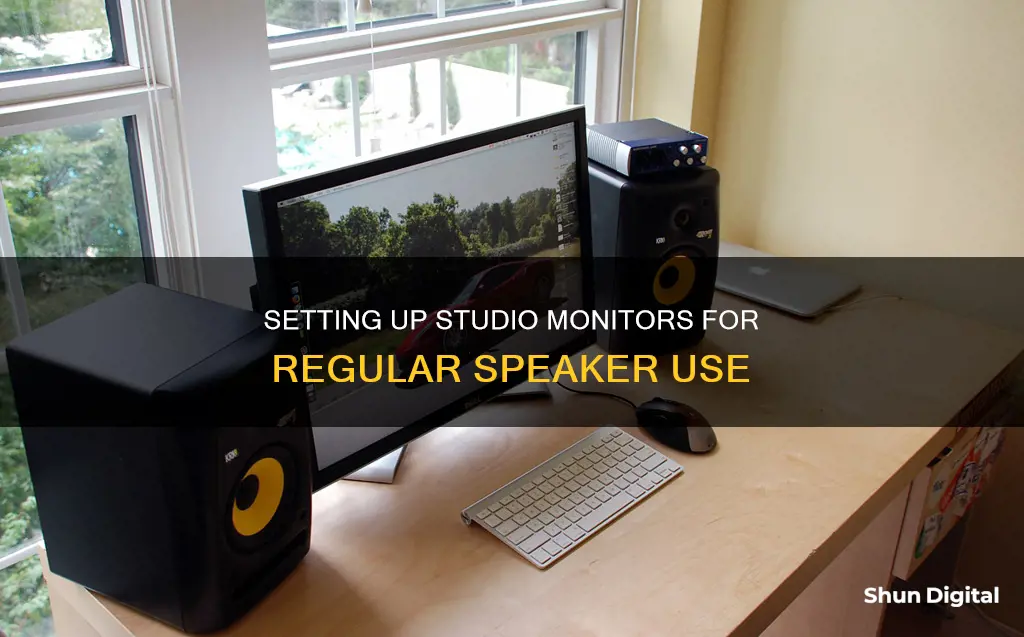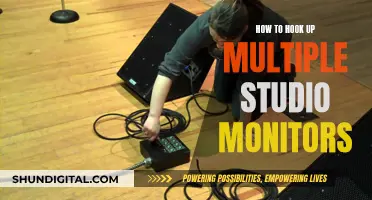
Studio monitors are designed for critical listening during the recording, mixing, and mastering process. They are meant to sound flat and precise, allowing you to identify and fix any sonic imperfections in your mix. In contrast, regular speakers are typically designed to sound good with any sound and in any space, often emphasising certain frequencies to enhance the listening experience.
Studio monitors are typically active, with built-in power amplifiers, while regular speakers are usually passive, receiving power from a standalone amplifier. Studio monitors also tend to have multiple power amplifiers in one unit, with individual amplifiers for the woofer, midrange, and tweeter, resulting in a more precise sound.
When setting up studio monitors, it is important to consider the listening position and speaker placement to achieve an accurate frequency response and a solid stereo image. The ideal setup is to form an equilateral triangle, with the distance between the left and right speakers and the distance from each speaker to the listener's head being equal. Additionally, the monitors should be positioned at ear height and angled slightly behind the listener's head to minimise high-frequency reflections off the side walls.
| Characteristics | Values |
|---|---|
| Speaker placement | Ideally, the listening position and the two monitors form an equilateral triangle. The distance between the left and right speakers and the distance from each speaker to the back of the listener's head should be equal. |
| Speaker placement and geometry | Studio monitors sound their best when listened to on-axis, so they should point directly at the listener's head. |
| Speaker height | The tweeters should be at the same height as the listener's ears when seated. |
| Speaker distance from walls | Place monitors either almost against the front wall or at least 43 inches (110 cm) away from it. |
| Speaker distance from each other | Acoustician Carl Tatz recommends nearfield speakers be spaced 67.5 inches (171.5 cm) apart. |
| Speaker isolation pads | Speaker isolation pads help mitigate vibrations and resonances by absorbing them before they can transfer to the furniture. |
What You'll Learn

Speaker placement and geometry
The placement of your studio monitors is crucial in achieving an accurate frequency response and a solid stereo image. The ideal setup is to form an equilateral triangle with your listening position and the two monitors. This means that the distance between the left and right speakers and the distance from each speaker to the back of your head should be equal. A tape measure, string, or even a guitar cable can help you achieve this setup. While there are recommended starting measurements for the triangle, the most important thing is to ensure that each side is the same length.
Studio monitors sound their best when listened to on-axis, so make sure they point directly at your head, or slightly behind it. High frequencies are more directional than lower frequencies, so if the speakers are pointing too far off-axis, you may not hear the high frequencies accurately. As a general rule, we want the speakers to point directly towards our ears to minimise the high frequencies that bounce off the side walls.
Regarding height, the tweeters of the studio monitors should ideally be at the same height as your ears when seated. This is typically about 47-55 inches (120-140 cm) from the floor. If you need to clear the top of your computer monitor, the speakers can be placed slightly higher and tilted down towards you. However, tilting speakers is a precarious way to set them up, and care must be taken to avoid them toppling over.
Positioning your head inside the triangle ensures a natural stereo "sweet spot", allowing you to move around a bit and even have a collaborator sit next to you. It is recommended to space nearfield speakers about 67.5 inches (171.5 cm) apart, but this is just a starting point and can be adjusted based on your setup.
If your room setup forces you to sit closer to the front wall, you can move the monitors closer together to achieve an equilateral triangle. The size of the triangle can also be adjusted based on the physical size of your speakers. If they are large, a larger triangle will likely make sense, and vice versa.
It is best to place your monitors almost against the front wall or at least 43 inches (110 cm) away from it. If the speakers are placed close to the front wall, their bass response will be exaggerated. Many monitors provide onboard EQ settings to compensate for this, such as whole-space (flat EQ for placement away from any walls), half-space (slight bass reduction for placement near the front wall), and quarter-space (increased bass reduction for placement near front corners).
If your speakers have a rear port, keep them away from the wall by at least the same distance as the diameter of the port, usually about 5 to 10 centimeters. Speakers placed with their front surface between 15 and 44 inches (38-110 cm) from the front wall can create uneven bass response due to low-frequency reflections. Similarly, try to maintain a distance of at least 44 inches from the nearest side wall. If your speakers must be placed near a side wall or a corner, use the quarter-space EQ setting to mitigate any extra bass build-up.
Speaker placement should be either close to the front wall or more than 44 inches (110 cm) away from it. Placing the speakers in between these distances can cause speaker-boundary interference (SBIR), resulting in low-frequency cancellations.
To summarise, careful monitor placement and isolation are essential for achieving the most accurate sound from your speaker system. Once your setup is optimised, you can employ electronic room correction to fine-tune the final touches.
Hong Kong Monitor Shopping: Where to Buy?
You may want to see also

Active vs passive monitors
Studio monitors can be either active or passive. Active monitors have built-in amplifiers, meaning you don't need an external amplifier to use them. Passive monitors, on the other hand, require an external amplifier to work.
Active monitors are simpler to set up and use, as they don't require any additional equipment. The built-in amplifiers are also specifically designed for and tuned to the monitors, which can lead to better overall sound quality. Passive monitors, however, offer more flexibility as you can choose an external amplifier that best suits your needs.
Another difference between the two is the ability to upgrade. With passive monitors, you can upgrade the speakers and amplifier separately, allowing for a more gradual and cost-effective progression to better-quality gear. With active monitors, upgrading requires changing both the speaker and its integrated amplifiers, which can be a larger financial step.
In terms of sound quality, active monitors tend to offer more precise sound reproduction and greater control over the frequency response. This is because each driver (woofer, midrange, and tweeter) in an active monitor has its own dedicated amplifier, allowing for more precise sound reproduction. Passive monitors, on the other hand, typically have a single amplifier that powers all the drivers, which can result in less precise sound reproduction.
When choosing between active and passive monitors, consider your needs, preferences, and budget. If you want a plug-and-play solution that is reliable and accurate, active monitors are a good choice. If you want more flexibility and are willing to put in some extra effort, passive monitors may be a better option.
USB-DVI Connection: Easy Monitor Setup Guide
You may want to see also

Amplifier configurations
The single-amp configuration is the simplest setup, typically found in computer speakers. In this configuration, the left and right speakers are powered by a single amplifier, usually integrated into one of the speakers. While common, this setup offers limited control over the frequency response.
The bi-amp configuration, on the other hand, provides greater control and more precise sound reproduction. It features two amplifier modules in each speaker, with each driver having its own dedicated amplifier. This setup is often used in professional studios where accuracy and detail are crucial. Some 3-way speakers also use a variation of this configuration, with one amplifier channel for the woofer and the other for the midrange speaker and tweeter, although this is not ideal for 3-way systems.
The tri-amp configuration is the most advanced and complex option, typically found in high-end professional studios. In this setup, each driver in a 3-way speaker (woofer, midrange, and tweeter) has its own dedicated amplifier for low, mid, and high frequencies, respectively. This provides ultimate control over the frequency response and ensures the most precise sound reproduction.
For those looking to use studio monitors as regular speakers, the amplifier configuration chosen will depend on the specific needs and requirements of the setup. The bi-amp and tri-amp configurations offer superior precision and control over the frequency response, making them ideal for professional studio environments. However, the single-amp configuration can also be considered for simpler or more casual setups.
Is Your Internet Traffic Being Watched?
You may want to see also

Monitor size
When it comes to the size of studio monitors, several factors come into play, including the size of your room, the style of music you produce, and the specific needs and preferences of the user.
For home studios, 5-inch speakers are generally a good fit as they offer a balance between low and high-frequency responses. Larger speakers are better suited for genres like EDM, which require a stronger low-frequency response, as they can move more air to reproduce lower-frequency sounds. On the other hand, smaller speakers are more accurate in the midrange and high-frequency responses due to their compact size.
The size of the studio monitor driver is influenced not only by room size but also by the music style. If you work with music that demands a lot of low-end, such as EDM, larger drivers are recommended. However, for music styles that focus more on the midrange and high-end frequencies, smaller drivers will be more suitable.
Additionally, the size of your monitors will also depend on whether you opt for a 2-way or 3-way design. A 2-way design typically includes a woofer for low frequencies and a tweeter for high frequencies, while a 3-way design introduces a third component, a midrange speaker, dedicated to enhancing clarity in the crucial middle frequencies.
When choosing the size of your studio monitors, it's important to consider not only the size of the room but also the specific requirements of your music production and your personal preferences.
Adjusting Screen Resolution: Reducing League Size on Large Monitors
You may want to see also

Wattage
For a small-to-medium-sized room, a studio monitor with 50-75 watts per channel will be sufficient. However, for a larger commercial studio, you may require a higher wattage, such as 100 watts or more per channel. It's worth noting that a higher wattage doesn't always indicate a better option. A well-designed, high-quality studio monitor with a lower wattage rating may outperform a cheaper monitor with higher wattage.
The best way to determine the appropriate wattage is to test the monitors in your room and listen to your material. If they can produce the desired sound pressure level without distortion, then that wattage is suitable. If you require a higher volume, consider a monitor with a higher wattage rating.
Upgrading Studio Monitors: Signs You Shouldn't Ignore
You may want to see also
Frequently asked questions
Studio monitors are designed to have a flat frequency response, meaning all frequencies are played at the same volume level. This is to ensure an accurate balance of frequencies when mixing. Regular speakers, on the other hand, are often "biased" to emphasise certain frequencies, such as adding more bass or boosting treble to create a more vibrant and crisp listening experience.
The ideal setup is to have your listening position and the two monitors form an equilateral triangle, with each side being of equal length. The monitors should be placed on stands or a mixing console, with the tweeters at the same height as your ears when seated. This ensures a natural stereo "sweet spot" and minimises high frequencies bouncing off side walls.
There are several amplifier configurations available: single-amp, bi-amp, and tri-amp. Single-amp is the simplest, with both left and right speakers powered by a single amplifier. Bi-amp offers greater control over frequency response, with each driver having its own dedicated amplifier. Tri-amp is the most advanced, providing the ultimate control over frequency response with a dedicated amplifier for each driver.
The size of the studio monitor speakers depends on your room size and music style. 5-inch speakers are generally a good fit for home studios. If you produce EDM music, for example, you may require larger speakers for better low-frequency response. Smaller speakers are typically better for midrange and high-frequency response due to their accuracy at reproducing these frequencies.
Wattage determines the monitor's ability to deliver sound without distortion. For smaller rooms or beginners, 50-75 watts per channel is a good starting point. For larger commercial studios, you may need 100 watts or more per channel. Quality is also important; a well-designed, high-quality monitor with lower wattage can often outperform a cheaper one with higher wattage.







